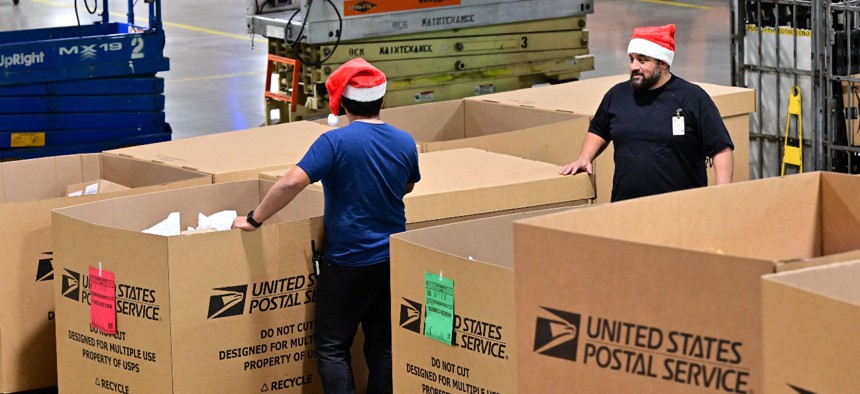
U.S. Postal Service employees sort mail at the Los Angeles Processing and Distribution Center in preparation for another busy holiday season on November 30. FREDERIC J. BROWN/AFP via Getty Images
USPS Regulator Throws Cold Water on Lawmakers' Concerns Over DeJoy's Authority for Big Price Hikes
The system is "working as intended," commission says.
The U.S. Postal Service needs its authority to issue large price hikes and has acted appropriately in implementing them, its regulator found in a new report issued in response to questions from lawmakers.
Congress required the in-depth, 628-page review in the fiscal 2022 omnibus funding package that President Biden signed into law in March. Lawmakers raised concerns about the “size and timing” of USPS’ first use of its new authority that allowed for above-inflation rate hikes in August 2021, when postal management increased the cost of regular, First-Class mail by 6.8%. The law called on the Postal Regulatory Commission to once again determine if USPS should maintain its extra capacity to bump rates, particularly in the wake of the COVID-19 pandemic and the financial relief Congress provided.
The new system, finalized in 2020, ties price caps to what the regulatory commission identified as USPS’ two biggest cost drivers: fewer pieces of mail going to more addresses and mandatory payments the agency must make toward benefits for future retirees. Postal management previously could only raise rates in line with inflation.
The commission stood by its revamped system, stressing it helps USPS better withstand the long-term pressures it faces. The pandemic created more package business for the Postal Service, but PRC noted its formula requires smaller price hikes during such periods. While Congress provided a $10 billion loan to USPS that was later converted to a grant as part of a COVID-19 relief package, PRC said that addressed “short-term operating needs” and would not impact the agency’s more deeply rooted financial issues. Additionally, the commission said, the U.S. Court of Appeals for the D.C. Circuit in 2021 affirmed the new authority was reasonable and not materially impacted by the pandemic.
PRC received an influx of input from stakeholders who criticized the price-setting authority and said the regulator failed to consider all factors. The commission dismissed those complaints as either outside the parameters of its narrowly focused review or simply reiterating concerns it has already addressed.
The fight for some stakeholders continues, however. Several industry groups have asked the postal regulator to revoke the new rate-setting authority, noting the Postal Service’s financial outlook has changed dramatically since President Biden signed a reform measure into law. That petition is currently pending before the commission. Rep. Gerry Connolly, D-Va., has introduced legislation to revoke the new authority and task PRC with developing a replacement one.
Postmaster General Louis DeJoy has promised to use his price-setting authority “judiciously,” but predicted USPS would generate between $35 billion and $52 billion by 2031 by raising prices. Some lawmakers and stakeholders have criticized DeJoy’s dual approach of raising rates while slowing down delivery for some mail, arguing it will accelerate losses to mail volume. DeJoy has defended his strategy as necessary to set realistic goals and put the agency on firmer long-term financial footing.
The Postal Service announced in October it would implement a 4.2% overall increase to First-Class mail prices beginning in January, after announcing a 6.5% spike in July. PRC noted those jumps were driven primarily by high inflation and were largely unaffected by the new rate-setting authority. It concluded the lawmakers’ concerns were without merit.
“In sum, the size and timing of the August 2021 rate increase were consistent with all applicable laws and demonstrated that the modified ratemaking system was working as intended to address discrete drivers of the Postal Service’s net losses that are out of its direct control,” the commission said.







